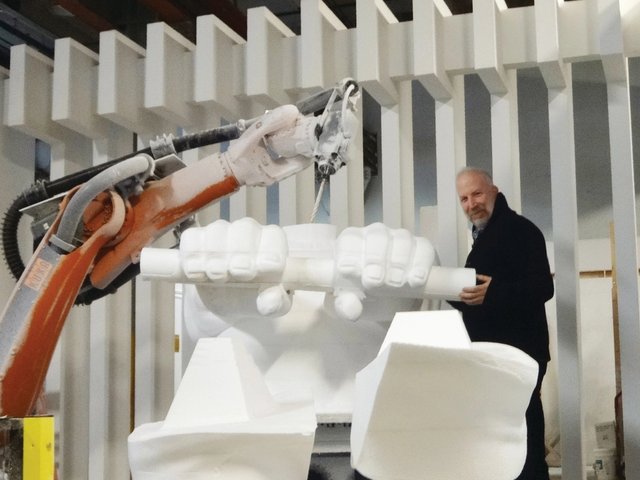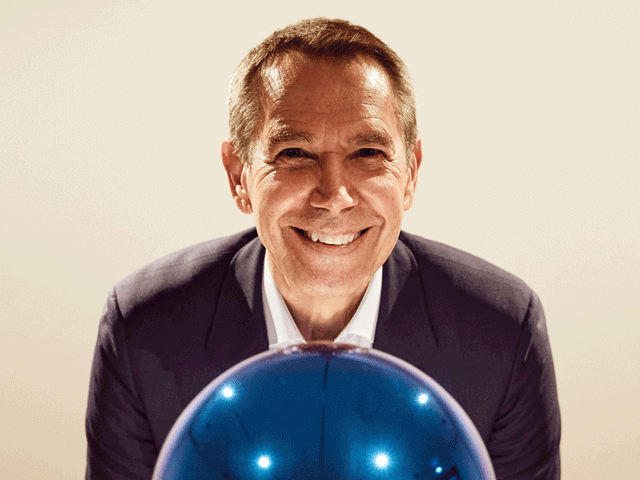Jeff Koons is ramping up operations at his high-tech stone workshop in Morrisville, Pennsylvania, where his sculptures are carved almost entirely by machines. This suggests that the artist may be developing new bodies of work in the medium. Since opening Antiquity Stone in 2012, Koons has more than tripled its production capacity; it now has 12 computer-operated stone-cutting machines, two robots and around 30 employees. The facility, which exists solely to fabricate Koons’s work, now bills itself as “the most advanced stone fabrication operation in the world”, according to a job advertisement it posted in January, seeking a supervisor for its Computer Numerical Control (CNC) machines.
“Over the past few years, [Koons] has shown a much greater interest in the medium, tackling a variety of new subjects and on a much larger scale,” says Scott Rothkopf, the curator of the artist’s retrospective at the Whitney Museum of American Art in New York last year.
Computer-based fabrication
“Jeff had a lot of ideas for stone, and [opening the centre] was the most advantageous way to produce his own work,” says Jon Lash, the president of Digital Atelier, a computer-based sculpture fabricator in New Jersey. Lash often works with the artist to fabricate works, including Koons’s 16ft-tall plaster statue of the pop star Lady Gaga straddling a metallic blue sphere, from his 2013 “Gazing Ball” series. Antiquity Stone has machines that range in price from $200,000 to $600,000 each, and “there is not another facility in the US that can do what Koons needs”, Lash says.
Those needs include carving monumental sculptures—which take more than two years to cut, mill and polish—from single 12- to 15-tonne blocks of stone, Lash says. “Koons usually begins with extremely high-resolution scans of his source object”—a photograph of Lady Gaga, for example, or a toy-store figurine—“that are then used to make 3D renderings,” Rothkopf says. “These ultimately guide a multi-axis milling machine that carves or drills into the chosen stone.” This equipment, for which Koons has been seeking specialist operators, is “very uncommon even in commercial manufacturing”, he says.
Koons’s operation is an offshoot of the non-profit Johnson Atelier Technical Institute’s stone division, which ran an apprentice programme in historic restoration and contemporary fabrication until it closed in 2003. Christoph Spath, the director of the programme, later turned the defunct organisation into a company called Advanced Stone Technologies. Koons became a client and bought the business in 2012. He moved it from New Jersey to a larger, 60,000 sq. ft space in Morrisville and hired Spath to run it.
Meanwhile, two key employees from the New York-based foundry Polich Tallix, which has cast and mirror-polished many of Koons’s works over the years, decamped to open their own business, Workshop Art Fabrication, in January.
It remains to be seen whether Koons will transfer any fabrication of new sculptures to this new foundry, which is currently working on existing editions. But its co-owner Andrew Pharmer understands Koons’s habit of conceptualising—and even selling—sculptures before the technologies exist to make them; Pharmer managed the lengthy fabrication of Koons’s monumental sculpture Play-Doh, 1994-2014, which was shown for the first time at the Whitney last year. The work languished for decades while Koons experimented with materials that could convey the cracks in its surface. His stone facility is facing similar challenges. The “work is very technical”, Lash says. “Hiring the right people has been slow, but it’s getting there.”
Originally appeared in The Art Newspaper as 'Koons at cutting edge with giant stone mills'



